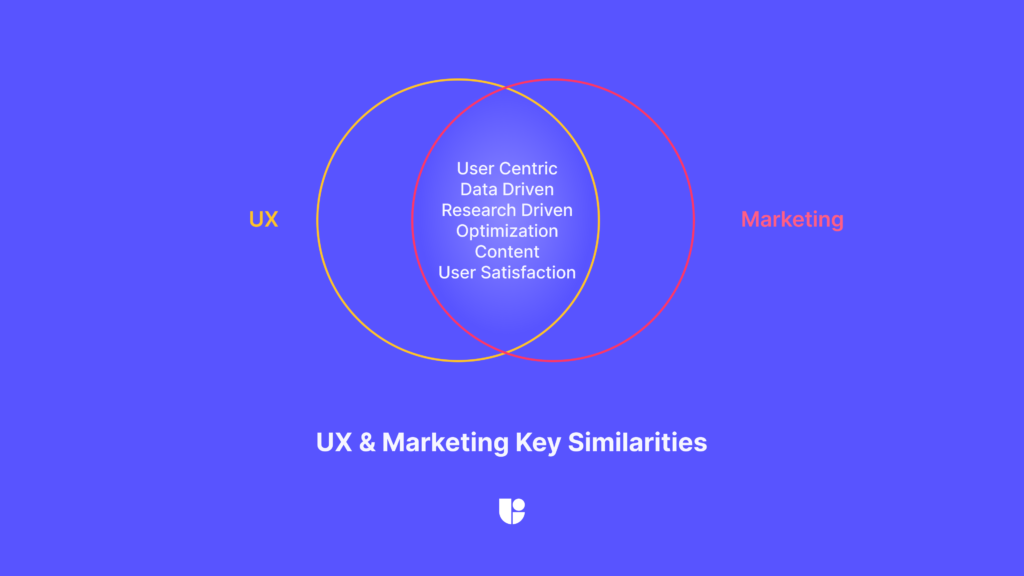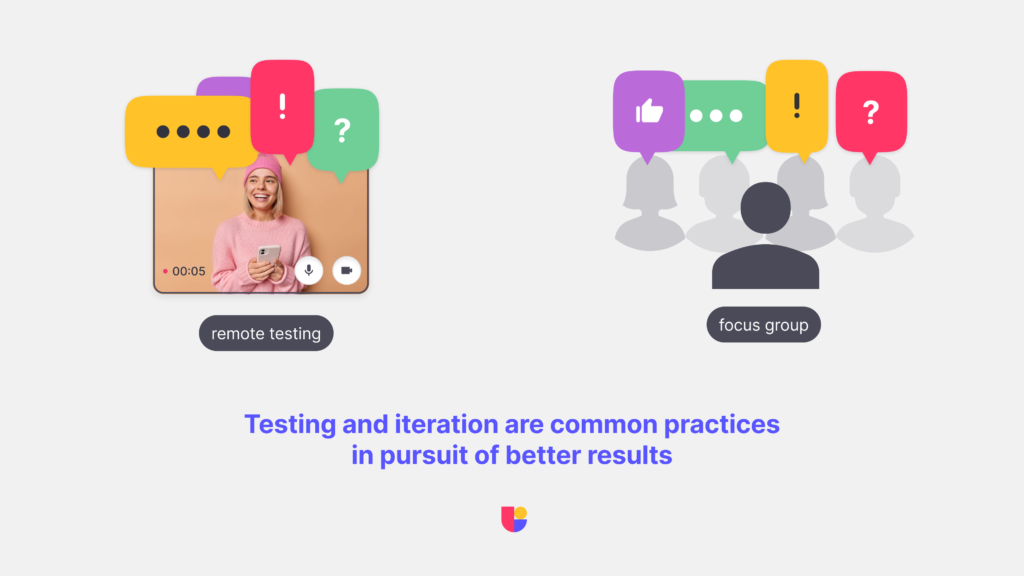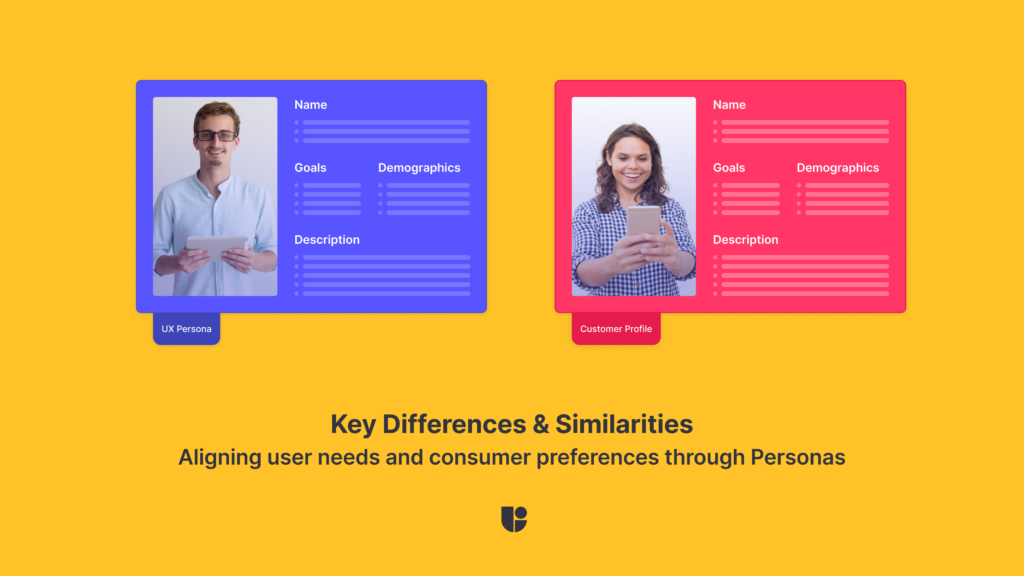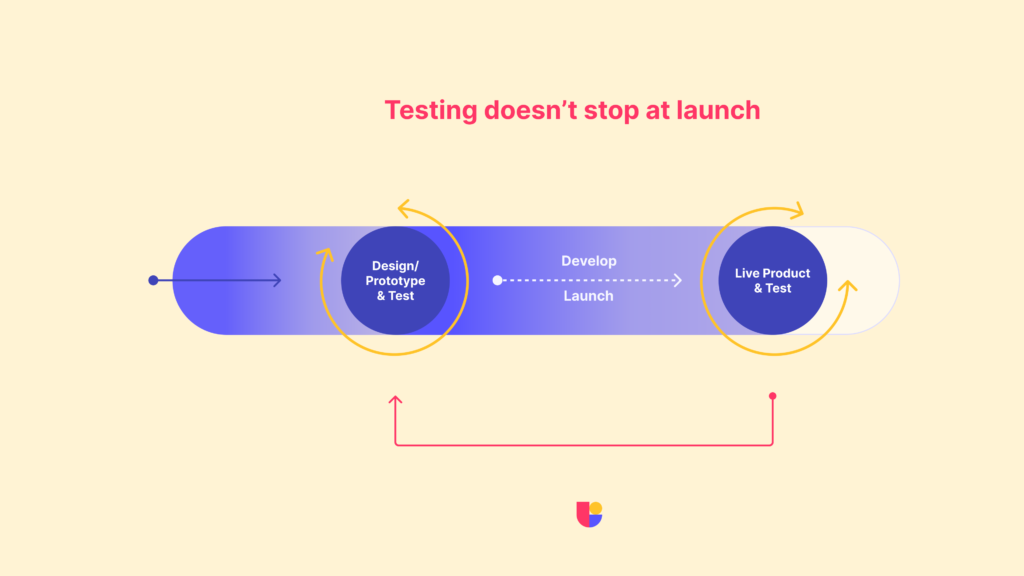Understanding your audience and the needs of your consumers is a strategic goal for any marketing team. Yet, in this age of rapid technological advancements, product innovations, and evolving consumer expectations, keeping pace can be a difficult challenge. This is where UX User Testing steps into the spotlight. A strong UX team presents marketers with a profound, data-driven insight into the minds and behaviors of their target audience.
In this blog post, we’ll explore the similarities between UX and marketing goals. How UX User Testing can be a game-changing tool for marketers to have a new way to understand their audience. As well as, present how UX support ultimately leads to more effective and empathetic marketing campaigns that are seamlessly in tune with their customers’ needs.
UX and Marketing Similarities
UX and marketing teams are closely aligned in terms of their interests, objectives, and goals in any successful business. Both teams will have “people” at the center of their focus as users or consumers. Both teams prioritize data-driven, user-centric decisions. Furthermore, they both seek to improve a product’s or service’s appeal with their own business unit’s efforts. So the obvious question here is:
Can UX and marketing teams work together and increase their effectiveness?
Let’s look in more detail at how UX and marketing are similar. In what way UX and user testing can support marketing:
Briefly, we can summarize that the key similarities between UX and marketing revolve around their user-centric approaches, the use of data to drive decisions, their shared commitment to user satisfaction, continuous improvement, testing, content creation, and the optimization of conversion rates. Recognizing these commonalities can lead to more effective collaboration between UX and marketing teams. Their combined efforts would result in the development of more cohesive, user-centric strategies.

User Behavior Analysis and Data
Both disciplines rely heavily on analyzing user behavior and leveraging data to make informed decisions. UX professionals observe and collect data on how users interact with products or applications to identify pain points and areas for improvement. Similarly, marketers track user engagement and response to their content and campaigns. They use data to assess performance, measure the user’s likes and dislikes, optimize strategies, and enhance user engagement. Data is a common language that informs strategies in both fields. Understanding how the data gathered by one team could be made applicable to the other is crucial for building synergy between the UX and marketing teams.
Testing and Optimization
A/B testing, usability testing, and other similar forms of studies are not only part of UX user testing but integral to marketing research as well. UX teams use testing to improve product design and interface usability for better user experiences. Likewise, marketers utilize testing to optimize campaign elements, messaging, and branding to have more impactful communications that improve conversion rates. A product that offers better UX is adopted more easily and leads to long-term, brand-loyal users. Likewise, a better-marketed product has higher awareness and brand recognition. This makes it easier for customers to recognize and evaluate the product, which leads to trial and adoption. Testing and iterative improvement are shared practices in the pursuit of better results for both of these teams.
If you are interested in checking out UX usability testing and how it can support your team, you can try Useberry’s Website Usability Testing for free!

Continuous Improvement and Feedback Loops
Both UX and marketing are characterized by their commitment to continuous improvement. UX professionals iterate on product designs based on user feedback and changing needs. Marketers constantly refine campaigns and targeting based on user data and feedback on changing market environments and consumer trends. Feedback loops are essential for both to ensure ongoing enhancements and user satisfaction. If one of these teams recognizes an emerging trend, it would be beneficial to share it with the other to stay up-to-date and ready in a dynamic environment. For example, any new emerging trend in visual or auditory preferences could be relevant for both UX and marketing teams and easily influence their upcoming design or campaign decisions.
User Personas and Customer Profiles
In both UX and marketing, the concept of creating user personas or customer profiles is prevalent. UX designers utilize these personas to design products with specific user segments in mind. Simultaneously, marketers employ these personas to customize campaigns for different target audiences. The idea is to create tailored experiences and messages that address the specific needs and preferences of various groups. Making sure that UX Personas and marketing target groups are aligned will lead to higher customer satisfaction. It will also make it easier to transfer any new knowledge about personas to actionable insights for more effective marketing communications.
Although a marketing target group could be divided based on criteria such as geographic or demographic groups, behavioral grouping is still a key criterion where UX personas will have a clear overlap.

Data-Driven Decision Making
It is almost unthinkable for a marketer to make a business decision on a “hunch”. A good marketer makes sure to make informed decisions every step of the way. This is something they have in common with the UX team, which is focused on gathering data through methods such as user testing. UX studies provide a wealth of data that can serve as an initial compass for marketers, guiding them toward strategies and campaigns that are not only effective but also resonant with the audience. Making decisions based on assumptions could be very dangerous, and if you would like to see an example of how you can use UX studies to help against this problem, you can take a look at one of our other articles on “Challenging Assumptions in UX Design”.
Understanding user preferences will lead to better decision-making when it comes to content strategy. During the design process, a UX team would have gathered a treasure trove of data from effective testing. Invaluable knowledge about user preferences could be passed on to marketing teams that include things like page layout, patterns, content density, attention span, color palette, brightness, tech-savviness, and content type. Armed with these insights, a marketer can adapt the campaign strategy to create effective material that will be more engaging to the target audience. Such content will seamlessly fit in with the target audience’s needs and be received more positively.

How UX & User Testing Contribute to Post-Launch Success
For someone who is not in the UX industry, user testing might sound like a process that ends when the product goes live, but that is far from the truth. It is a continuous process that can carry on throughout the lifetime of the product or service. It could heavily contribute to the success of marketing efforts post-launch.
1. Continuous Improvement of the User Experience:
Continuous testing helps identify areas for improvement in the user experience. This ongoing process ensures that users have a consistently positive interaction with your digital assets, which is essential for post-launch success. Making sure that your brand leaves a positive imprint in the minds of your consumers is a big bonus to your marketing efforts, and it will make the consumers much more open to future marketing campaigns and communication messages.
2. User Feedback Loops:
Encourage users to provide feedback on their experiences with your product or service. This feedback, whether through surveys, reviews, or direct communication, can be analyzed in conjunction with UX data. Marketers can use this information to highlight pain points, fix their messaging, and emphasize communicating crucial improvements. Surveys are a very common method of User testing which marketers will be familiar with. You could try a survey demo right on our website in the Online Surveys section.
3. Performance Monitoring:
UX data can help track the performance of your digital assets post-launch. It can provide insights into website or app speed, response times, performance, user behavior, and error rates. Marketers can use this data to ensure that technical performance meets user expectations, which is crucial for retaining and attracting users. Putting UX data on top of the marketing data can help clarify confusing results from a campaign and help to present a more holistic picture when it comes to analyzing and reporting data.
For example, learning about a large number of crashes on the website due to higher-than-expected traffic could explain why a big promotion did not result in higher conversions over the same period. Analyzing your website with Interactive Clicks and reviewing the resulting data and heatmap might point out that the new promo banners being in a “cold” area of the screen was the reason for the lower-than-expected CTR on the AD campaign.
4. Content Strategy Refinement:
Post-launch, marketers can use UX data to refine content strategies. Analytics and user testing can reveal which content is most engaging and effective. Marketers can create more content that resonates with users, enhancing user retention and engagement without having to do their own trial-and-error runs or A/B testing for content material.
Human behavior patterns are what inspire marketing and user experience teams to act. Therefore, many of the methods used by these fields to better understand behaviors are quite similar to each other. For example, A/B testing is a common practice in both marketing and UX user testing. Instead of random variations, you can use insights from user testing to inform your A/B test hypotheses. For instance, if user testing indicates that users find a banner on the website confusing, you can A/B test alternative banners to see which one leads to better user engagement and conversions. A marketer can take the learnings from these tests and make better marketing materials overall, such as digital creatives, pop materials, ADs, etc.
If you are a marketer who would like to know more about Website Testing and how it can be useful, our article on “All you need to know about Website Usability Testing” has you covered!

Supporting User Loyalty and Retention
User Experience (UX) significantly contributes to customer loyalty and retention in marketing by focusing on creating positive and memorable interactions. A well-designed and user-friendly interface enhances user satisfaction, as it ensures that users can easily navigate and achieve their goals on your digital platforms. Satisfied users are more likely to return and continue engaging with your brand, forming the basis of customer loyalty. Additionally, a smooth user journey with reduced friction points minimizes obstacles and frustrations. Better user experiences lower the chances of users abandoning your platform. Consistency and familiarity in design and navigation create a sense of comfort and predictability, further encouraging users to return. UX-driven personalization customizes the user experience to individual preferences and needs. This individual experience seamlessly strengthens the connection between users and your brand.
Proactive customer support, identified through UX testing, provides users with assistance in problem areas. Helping retain customers who might otherwise become frustrated and look elsewhere. Moreover, UX practices include gathering user feedback to understand customer satisfaction and areas for improvement. This allows marketers and product teams to respond to customer concerns promptly.
Ultimately, a well-designed, user-friendly digital presence not only enhances the user experience but also contributes to a positive brand perception. In this case, UX support seamlessly increases customer loyalty and retention.
Competitive Advantage Through UX & User Testing
User Experience is a powerful ally for marketing teams seeking to maintain a competitive advantage. A well-designed user interface can serve as a unique differentiator, setting your brand apart from competitors. UX professionals prioritize visually appealing and intuitive designs that provide the features customers need. A memorable and attractive digital experience increases the chances of user satisfaction.
Furthermore, a seamless and user-friendly digital interface created using UX principles can significantly increase conversion rates. When your website or app makes it easier for users to complete desired actions, such as making a purchase or signing up, you gain a competitive edge by capitalizing on these conversions.
Marketers can leverage UX research and data for personalized marketing campaigns. Marketing teams can craft content and offers that are closely aligned with individual needs with better knowledge of user behavior and preferences. Personalized content has a better chance of engaging users and driving conversions, giving you a competitive advantage in targeted marketing.
Efficient resource allocation is another area where UX shines. A data-driven UX approach helps you identify the most effective marketing channels and messaging for your specific audience. By allocating resources more efficiently, you can outperform competitors who may need to invest more productively. Additionally, UX research can offer insights into the user experiences provided by your competitors. By understanding where competitors may be falling short, you can strategically position your brand as the superior choice, gaining a competitive edge.

Conclusion
In conclusion, the symbiotic relationship between user testing and marketing is evident in the shared objectives, methodologies, and outcomes. It is important to recognize the commonalities between UX and marketing. Starting from their user-centric approaches to the continuous pursuit of improvement lays the foundation for a collaborative and effective partnership. The integration of UX insights into marketing strategies, from user behavior analysis to data-driven decision-making, fosters campaigns that resonate with the audience on a deeper level.
Feel free to contact us!
Would you like to know how Useberry can support both your UX and Marketing efforts?




